Working with clay is a really hands-on activity that kids can get into, and it's a great way to teach them a little about history. The Roman Colosseum is a beautiful example of ancient architecture, and can give them a little insight into the world of the ancient Romans. One great way to keep them engaged while teaching them about the building and its history is to have them build it with you out of clay.
- Working with clay is a really hands-on activity that kids can get into, and it's a great way to teach them a little about history.
- One great way to keep them engaged while teaching them about the building and its history is to have them build it with you out of clay.
Trace around your plate or round object using a marker on the cardboard or wooden base. The Colosseum is build on a circular base.
Place a thin strip of clay on the base, covering the circular mark.
Cut a drinking straw into an arch shape, and cover it in clay to build an arch. Stick this arch on the clay base.
Repeat to build a second arch. Stick this on the clay base next to the first, with enough space between the two for another arch.
Attach a small lump of clay between the top of the two arches to make another arch shape.
Make enough arches to fill the entire circle, and stick them on the base.
Build another arch and stick it on top of the first row. Place it above one of the clay lump arches on the row below.
Repeat the building of straw-filled arches to fill the second row. When finished, build a third row on top of that.
- Repeat to build a second arch.
- When finished, build a third row on top of that.
Insert a skewer into the clay, through the inside of the Colosseum, to support the building. Repeat around the building, so that the whole building stays together.
Extend the top wall of the colosseum with more clay. The topmost layer of the Colosseum is about as tall as one of the arches on the layer below, but it lacks archways.
Use an extra skewer to carve brickwork into the outside of the Colosseum and give it texture. Carve the arches first, then carve brick patterns into the spaces between the arches.
